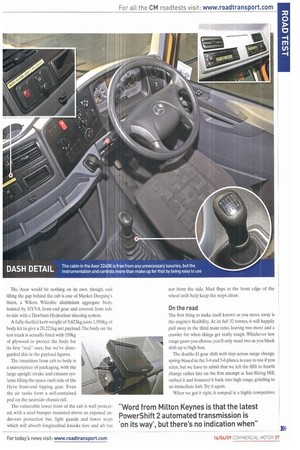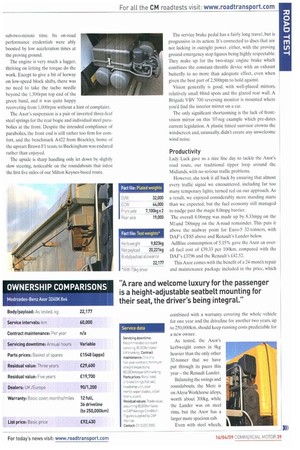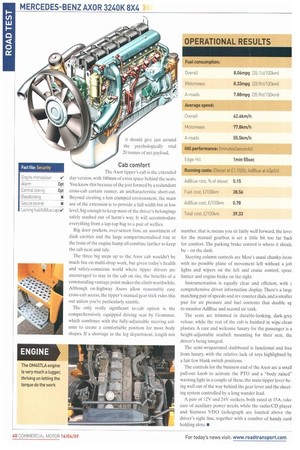Mercedes-Benz has long been a significant player in the construction
Page 36

Page 37

Page 39

Page 40

If you've noticed an error in this article please click here to report it so we can fix it.
sector, most recently with the Actros 8x4. That model's toughness has never been in doubt, but the inevitable pay-off means it's never been a particularly attractive proposition where payload is crucial. After the odd false start trying to lighten the Actros, and a realignment of model branding, the answer has turned out to be the Axor 3240K. K is for kipper, German for tipper, and nothing to do with sleeping or smoking fish.
If the model took a while to devise, getting to test one was equally long-winded, and the example driven has done nearly 70,000km of real work, hence the '07 plates and a few less than pristine brackets around the body.
Merc's construction models now run from the 7.5 tonne Atego up to the Actros in 26 and 32 tonne rigid and 6x4 and 8x4 tractor form. The middle ground is the home of Axor, available for construction work as 4x2, 6x2, 6x4 and 8x4 rigids and 4x2 and 6x4 tractors. Phew! Whittling this lot down to the 8x4 leaves us with just one more major choice, engine rating. The 12-litre Euro-5 0M4571A straight-six motor, using AdBlue-fuelled SCR, of course, comes with hp and Nm ratings at 355/1,850,396/2,000 and 422/2,100, of which we're testing the middle option.
It's rare these days for us to find a manual transmission on a press test vehicle, but we had to dust off an unused left leg for the Axor's nine-speed direct-drive synchro 'box, there being no automatic option on offer. Word from Milton Keynes is that the latest PowerShift 2 automated transmission is "on its way', but there's no indication when, despite the take-up of clutchless tippers being around 20% across the market. Drive axles are single reduction units, with a ratio of 3.08:1, and straight "I" beams at the front. The drive axles feature the usual cross and inter-axle diff locks. The Axor would be nothing on its own, though. and filling the gap behind the cab is one of Market Deeping's finest, a Wilcox Wilcolite aluminium aggregate body hoisted by HYVA front-end gear and covered from side to side with a Dawbarn Hydroclear sheeting system.
A fully-fuelled kerb weight of 9,823kg joins 1,956kg of body kit to give a 20,221kg net payload.The body on the test truck is actually lined with 150kg of plywood to protect the body for its first "real" user, but we've disregarded this in the payload figures.
The transition from cab to body is a masterpiece of packaging, with the large upright intake and exhaust systems filling the space each side of the Hyva front-end tipping gear. Even the air tanks form a self-contained pod on the nearside chassis rail.
The vulnerable lower front of the cab is well protected, with a steel bumper mounted above an exposed under-run protection bar, light guards and lower steps which will absorb longitudinal knocks fore and aft but not from the side. Mud flaps at the front edge of the wheel arch help keep the steps clean.
On the road
The first thing to make itself known as you move away is the engine's flexibility. At its full 32 tonnes, it will happily pull away in the third main ratio, leaving two more and a crawler for when things get really tough. Whichever low range gears you choose, you'll only need two as you block shift up to high box.
The double-H gear shift with slap-across range change, spring-biased in the 3-4 and 5-6 planes, is easy to use if you relax, but we have to admit that we left the fifth to fourth change rather late on the first attempt at Sun Rising Hill, rushed it and bounced it back into high range, grinding to an immediate halt. Try it again.
When we got it right, it romped in a highly competitive sub-two-minute time. Its on-road performance credentials were ably boosted by low acceleration times at the proving ground.
The engine is very much a lugger, thriving on letting the torque do the work. Except to give a bit of leeway on low-speed block shifts, there was no need to take the tacho needle beyond the 1,500rpm top end of the green band, and it was quite happy recovering from 1,000rpm without a hint of complaint.
The Axor's suspension is a pair of inverted three-leaf steel springs for the rear bogie and individual steel parebolics at the front. Despite the intended compliance of parabolics, the front end is still rather too firm for comfort, and the benchmark A422 from Brackley, home of the upstart Brawn Fl team, to Buckingham was endured rather than enjoyed.
The upside is sharp handling only let down by slightly slow steering, noticeable on the roundabouts that infest the first five miles of our Milton Keynes-based route. The service brake pedal has a fairly long travel, but is progressive in its action. It's connected to discs that are not lacking in outright power, either, with the proving ground emergency stop figures being highly respectable. They make up for the two-stage engine brake which combines the constant-throttle device with an exhaust butterfly to no more than adequate effect, even when given the best part of 2,500rpm to hold against.
Vision generally is good, with well-placed mirrors, relatively small blind spots and the glazed rear wall. A Brigade VBV 700 reversing monitor is mounted where you'd find the interior mirror on a car.
The only significant shortcoming is the lack of frontvision mirror on this '07-reg example which pre-dates current legislation. A plastic tinted sunvisor crowns the windscreen and, unusually, didn't create any unwelcome wind noise.
Productivity
Lady Luck gave us a nice fine day to tackle the Axor's road route, our traditional tipper loop around the Midlands, with no serious traffic problems.
However, she took it all back by ensuring that almost every traffic signal we encountered, including far too many temporary lights, turned red on our approach. As a result, we enjoyed considerably more standing starts than we expected, but the fuel economy still managed to nudge past the magic 8.0mpg barrier.
The overall 8.06mpg was made up by 8.33mpg on the M1 and 788mpg on the A-road remainder. This puts it above the midway point for Euro-5 32-tonners, with DAF's CF85 above and Renault's Lander below. AdBlue consumption of 5.15% gave the Axor an overall fuel cost of £39.33 per 100km, compared with the DAF's £37.96 and the Renault's 142.52.
This Axor comes with the benefit of a 24-month repair and maintenance package included in the price, which it should give just around the psychologically vital 20 tonnes of net payload.
Cab comfort The Axor tipper's cab is the extended day version, with 180mm of extra space behind the seats. You know this because of the join formed by a redundant cross-cab curtain runner, an uncharacteristic short-cut. Beyond creating a less cramped environment, the main use of the extension is to provide a full-width bin at low level, big enough to keep most of the driver's belongings safely stashed out of harm's way. It will accommodate everything from a lap-top bag to a pair of wellies.
Big door pockets. over-screen bins, an assortment of dash cavities and the large compartmentalised tray at the front of the engine hump all combine further to keep the cab neat and tidy.
The three big steps up to the Axor cab wouldn't be much fun on multi-drop work, but given today's health and safety-conscious world where tipper drivers are encouraged to stay in the cab on site, the benefits of a commanding vantage point makes the climb worthwhile. Although on-highway Axors allow reasonably easy cross-cab access, the tipper's manual gear stick rules this out unless you're particularly nimble.
The only really significant in-cab option is the comprehensively equipped driving seat by Grammar, which combines with the fully-adjustable steering column to create a comfortable position for most body shapes. If a shortage in the leg department, length not number, that is, means you sit fairly well forward, the level for the manual gearbox is set a little bit too far bac} for comfort. The parking brake control is where it shoulc be — on the dash.
Steering column controls are Merc's usual chunky item: with no possible plane of movement left without a job lights and wipers on the left and cruise control, speec limiter and engine brake on the right.
Instrumentation is equally clear and efficient, with comprehensive driver information display. There's a large matching pair of speedo and rev counter dials, and a smallet pair for air pressure and fuel contents that double ur to monitor AdBlue and second air tank.
The seats arc trimmed in durable-looking, dark-gre2r velour, while the rest of the cab is finished in wipe-clean plastics. A rare and welcome luxury for the passenger is a height-adjustable seatbelt mounting for their seat. the driver's being integral.
The semi-wraparound dashboard is functional and free from luxury, with the relative lack of toys highlighted by a fair few blank switch positions.
The controls for the business end of the Axor are a small pull-out knob to activate the PTO and a "body raised" warning light in a couple of these, the main tipper lever being well out of the way behind the gear lever and the sheeting system controlled by a long wander lead.
A pair of 12V and 24V sockets, both rated at 15A. take care of auxiliary power needs, while the radio/CD player and Siemens VDO tachograph are loacted above the driver's sight line, together with a number of handy card holding slots. •








































































































































